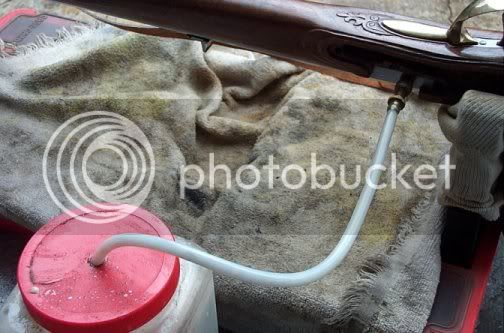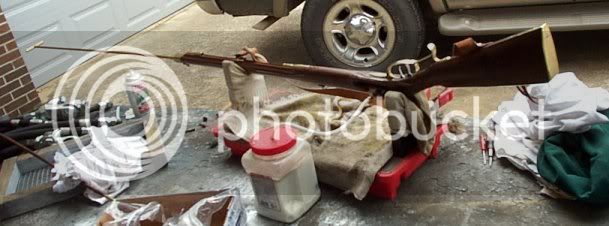This is how I clean mine & once ya get used to cleaning them like this, takes about 15 min to fully clean the rifle.
I use this method to clean all my flintlocks & percussions, longrifles
and halfstocks.
I use dishwater liquid soap & cold water for the flushing solution. (or 2 oz of Ballistol
per gallon of water in a jug)
I put the rifle upside down in a cradle & remove the lock & have the barrel end a little
lower than the buzzle. This way if I get any seepage out of the clamp or fitting, it stays
on the Outside bottom of the barrel & NOT down into the barrel channel.
Next thing I do is take a breech scraper & scrape the accumulated fouling off the breech
face. It takes about 15 seconds & knocks all that thick crud off the breech face. (Note:
they make a special scraper for a GPPR & T/C or you can take a standard blade scraper
in .36 cal & make one for them by rounding the edges of the blade to the contour of
the patent breech interior. On a 40-45 you may need a .32 cal on for this)
Then remover the range rod & invert the rifle muzzle down & bump the breech with your hand
& the fouling will fall out. Now put the rifleback in the cradle upside down & connect
the Flush Kit & wet a patch, put it on a jag on a range rod with a bore protector & take it to
the breech & then suck the barrel full of the solution & just leave the rod hanging out at
the muzzle, with the barrel full of solution. (You may need to support the rod at the handle).
Then while the barrel is soaking I & clean the lock asm. under faucet
with a old toothbrush, blow dry with air & or dry with a paper towel & take
a tiny screwdriver & work the towel into the cracks & etc., then spray
the lock down entirely including the flint, with Ballistol aerosol & pat dry with
a paper towel & set asside.
Back to the rifle in the cradle, I take a cleaning jag & a tight patch,
& start swabbing back & forth in full strokes to flush the barrel real
good for about 20 strokes. Change patches & do it again, change patches
and do it again til I am sure it is clean. Then I take the jag off & put on
a breech scraper & check for any fouling. Scrape if necessary & if there
is any fouling I put on a Breech Brush & brush the breech. The back to
the jag & wet patch & flush again.
Then I swab with a dry patch a time or two. I wad up 2 patchs
& put them in the bore & shove them to the breech with the jag
& hold it there tight with the ramrod & then take a worm & pull it
& check it for moisture & fouling. Then I do 2 more. And 2 more if
necessary to BE SURE THE BORE IS COMPLETELY DRY.
When dry, I then squirt a lil Non-Aerosol Ballistol in the barrel from a pump spray
bottle & wet a patch real wet with same Ballistol & again swab & force some
out the vent. (By doing this you just lubed the cone of the vent.
When I am satisfied it is lubed real good, I install the lock & close the frizzen on a dry
patch so any excess Ballistol will run out the vent & be absorbed in the patch at the frizzen.
You can do all the same with BreakFree which I used before I found Ballistol & it
works good also.
Now keep in mind this is not a Maybe this will work, this is a "I KNOW " it will work
proceedure.
Some tell me I go to too much detail, I know it works. I know I don't
have any rust in the bores of my rifles & have done this for 30+years, so it
must work.
It is IMPERATIVE that you get ALL of the moisture out of the barrel
and at the breech before you put the gun oil in the bore.
It is IMPERATIVE that you Reswab the bore the Next day & the
3rd day just to be sure you got it all lubed & etc.
Birddog6







